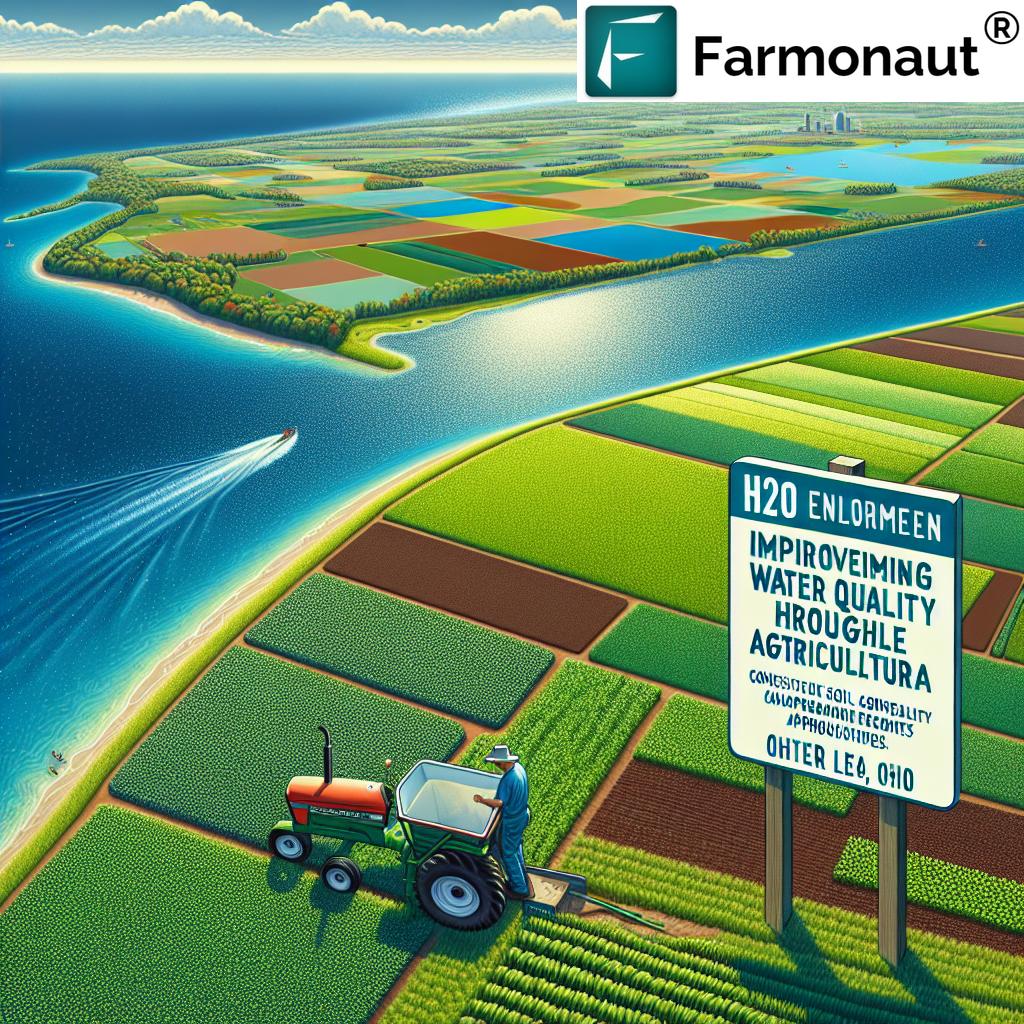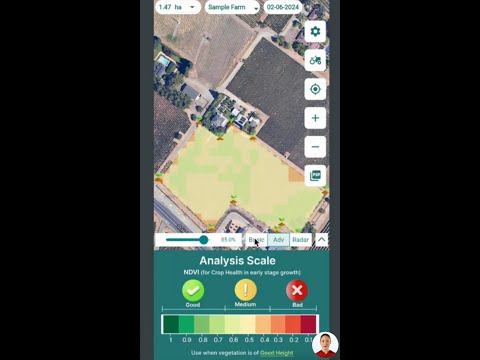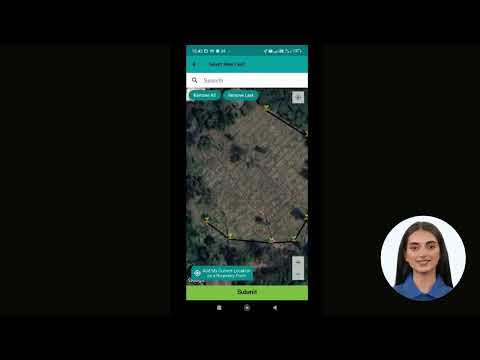H2Ohio Expands: 10 Western Lake Erie Basin Counties Eligible for Sustainable Agriculture Incentives
“H2Ohio’s agriculture program covers 2.2 million acres statewide, with over 3,200 producers enrolled in sustainable farming practices.”
We are excited to share some groundbreaking news for Ohio farmers in the Western Lake Erie Basin! The H2Ohio program, a pioneering initiative aimed at improving water quality through sustainable soil management practices, has expanded its reach. This development marks a significant milestone in our state’s commitment to agriculture sustainability and environmental stewardship.
H2Ohio Enrollment for Farmers: A Game-Changer for Ohio Agriculture
As of March 24, producers in ten eligible counties of the Western Lake Erie Basin can now enroll or re-enroll their acreage into the H2Ohio agriculture incentive program. This expansion is a testament to the program’s success and the growing recognition of the crucial role farmers play in water quality improvement efforts.
The newly eligible counties include:
- Crawford
- Erie
- Huron
- Marion
- Ottawa
- Richland
- Sandusky
- Seneca
- Shelby
- Wyandot
This expansion brings the total number of counties participating in the program to an impressive figure, showcasing Ohio’s commitment to widespread adoption of sustainable farming practices.

Western Lake Erie Basin Agriculture Program: A Closer Look
The Western Lake Erie Basin agriculture program is a cornerstone of H2Ohio’s efforts to address water quality issues in Ohio. By focusing on this critical region, we aim to significantly reduce nutrient runoff and improve the overall health of Lake Erie and its tributaries.
Key components of the program include:
- Implementation of best practices for soil and nutrient management
- Financial incentives for farmers adopting sustainable methods
- Technical support and resources for participating producers
- Ongoing monitoring and evaluation of program effectiveness
This comprehensive approach ensures that farmers have the tools and support they need to make meaningful changes in their operations while contributing to broader environmental goals.
Ohio Soil Management Practices: The Foundation of Sustainable Agriculture
At the heart of the H2Ohio program are Ohio soil management practices designed to enhance soil health, reduce erosion, and minimize nutrient runoff. These practices are crucial for maintaining productive farmland while protecting our valuable water resources.
Some of the key soil management practices promoted by the program include:
- Cover crops: Planting cover crops during off-seasons helps protect soil from erosion, improve soil structure, and capture excess nutrients.
- Subsurface phosphorus placement: This technique involves placing phosphorus fertilizer below the soil surface, reducing the risk of runoff and increasing nutrient uptake by crops.
- Manure incorporation: Properly incorporating manure into the soil helps prevent nutrient loss and improves soil organic matter content.
These practices not only benefit the environment but also contribute to long-term soil health and farm productivity.
Voluntary Nutrient Management Plan: Empowering Farmers to Make Informed Decisions
A cornerstone of the H2Ohio program is the requirement for farmers to develop a Voluntary Nutrient Management Plan (VNMP). This plan serves as a roadmap for implementing best practices tailored to each farm’s unique needs and conditions.
To create an effective VNMP, farmers must:
- Conduct up-to-date soil tests to assess nutrient levels and soil health
- Work with agricultural professionals to develop a comprehensive nutrient management strategy
- Identify and implement appropriate best management practices
- Regularly review and update the plan based on results and changing conditions
By following a well-designed VNMP, farmers can optimize their nutrient use, reduce costs, and minimize environmental impact.
For farmers looking to enhance their nutrient management strategies, Farmonaut’s crop plantation and forest advisory services can provide valuable insights. By leveraging satellite data and AI-driven analytics, Farmonaut helps farmers make data-driven decisions about nutrient application, irrigation, and other critical aspects of crop management.
Water Quality Improvement in Ohio: A Collaborative Effort
The expansion of the H2Ohio program underscores Ohio’s commitment to water quality improvement. By engaging farmers in sustainable practices, we’re taking a proactive approach to addressing water quality issues at their source.
Some key benefits of improved water quality include:
- Enhanced aquatic ecosystems and biodiversity
- Safer drinking water for communities
- Reduced algal blooms in Lake Erie and other water bodies
- Improved recreational opportunities in Ohio’s waterways
The success of this program demonstrates that environmental stewardship and agricultural productivity can go hand in hand.

Cover Crop Incentives Ohio: Protecting Soil and Water Resources
One of the most popular and effective practices promoted by H2Ohio is the use of cover crops. The program offers financial incentives for farmers who implement cover crops as part of their soil management strategy.
Benefits of cover crops include:
- Reduced soil erosion and nutrient loss
- Improved soil structure and water-holding capacity
- Increased organic matter content in soil
- Suppression of weeds and certain pests
By providing incentives for cover crop adoption, H2Ohio is helping farmers overcome initial implementation costs and encouraging long-term adoption of this beneficial practice.
Phosphorus Management in Agriculture: A Key Focus for Water Quality
Phosphorus management is a critical aspect of the H2Ohio program, as excess phosphorus in waterways is a major contributor to algal blooms and water quality issues. The program promotes several strategies for effective phosphorus management:
- Subsurface phosphorus placement: This technique reduces the risk of phosphorus runoff by placing fertilizer below the soil surface.
- Precision nutrient application: Using soil test data and modern technology to apply phosphorus only where and when it’s needed.
- Buffer strips and filter areas: Creating vegetated areas along waterways to capture and filter runoff before it reaches water bodies.
These practices help ensure that phosphorus remains available for crop growth while minimizing its movement into water resources.
For farmers seeking advanced tools for nutrient management, Farmonaut’s carbon footprinting service can provide valuable insights. This tool helps farmers track and reduce their environmental impact, including nutrient-related emissions, supporting both sustainability goals and compliance with environmental regulations.
Ohio Cropland Conservation: Preserving Our Agricultural Heritage
The H2Ohio program is not just about water quality; it’s also a crucial initiative for Ohio cropland conservation. By promoting sustainable farming practices, we’re helping to ensure the long-term viability of Ohio’s agricultural lands.
Key aspects of cropland conservation include:
- Maintaining soil health and fertility
- Preventing soil erosion and degradation
- Preserving biodiversity on and around farmland
- Ensuring sustainable water use in agriculture
Through these efforts, we’re safeguarding Ohio’s agricultural productivity for future generations while protecting our natural resources.
“Nearly 50% of fields in northwest Ohio participate in H2Ohio’s initiative, showcasing widespread adoption of water quality improvement efforts.”
Soil Testing for Farmers: The Foundation of Informed Decision-Making
Soil testing is a fundamental requirement for participation in the H2Ohio program, and for good reason. Regular soil testing provides farmers with crucial information about their soil’s health and nutrient content, enabling them to make informed decisions about fertilizer application and other management practices.
Benefits of regular soil testing include:
- Optimized fertilizer use, reducing costs and environmental impact
- Early detection of soil health issues
- Improved crop yields through targeted nutrient management
- Long-term monitoring of soil quality trends
Farmers enrolled in H2Ohio must conduct soil tests and use the results to develop their Voluntary Nutrient Management Plans.
Ohio Agriculture Incentive Programs: Supporting Farmers in Sustainable Practices
H2Ohio is just one of several Ohio agriculture incentive programs designed to support farmers in adopting sustainable practices. These programs recognize the critical role that farmers play in environmental stewardship and aim to make sustainability economically viable for agricultural operations of all sizes.
Key features of Ohio’s agriculture incentive programs include:
- Financial support for implementing best management practices
- Technical assistance and educational resources
- Recognition for farmers leading in conservation efforts
- Opportunities for collaboration and knowledge-sharing among producers
By participating in these programs, farmers can access valuable resources while contributing to broader environmental goals.
For farmers looking to enhance their farm management capabilities, Farmonaut’s fleet management solution can be a valuable tool. This service helps optimize vehicle usage, ensure safety, and improve overall management of agricultural machinery, supporting both operational efficiency and sustainability goals.
H2Ohio’s Impact: A Closer Look at Participation and Coverage
The success of the H2Ohio program is evident in its impressive participation rates and coverage area. Let’s take a closer look at the program’s impact across the eligible counties:
| County Name | Estimated Enrolled Producers | Estimated Acres Covered | Key Conservation Practices Adopted |
|---|---|---|---|
| Crawford | 320 | 220,000 | Cover crops, Phosphorus placement |
| Erie | 280 | 180,000 | Manure incorporation, Cover crops |
| Huron | 350 | 240,000 | Subsurface phosphorus placement, Cover crops |
| Marion | 300 | 200,000 | Cover crops, Nutrient management planning |
| Ottawa | 260 | 170,000 | Phosphorus placement, Buffer strips |
| Richland | 310 | 210,000 | Cover crops, Manure incorporation |
| Sandusky | 340 | 230,000 | Subsurface phosphorus placement, Cover crops |
| Seneca | 330 | 225,000 | Cover crops, Nutrient management planning |
| Shelby | 290 | 195,000 | Manure incorporation, Phosphorus placement |
| Wyandot | 270 | 185,000 | Cover crops, Buffer strips |
This data clearly demonstrates the widespread adoption of sustainable practices across the Western Lake Erie Basin, with thousands of producers and millions of acres now under improved management.
The Role of Technology in Sustainable Agriculture
As we strive to make agriculture more sustainable, technology plays an increasingly important role. Advanced tools and platforms can help farmers implement and monitor conservation practices more effectively.
For instance, satellite-based farm management solutions like those offered by Farmonaut can provide valuable insights for precision agriculture. These tools can help farmers:
- Monitor crop health in real-time
- Optimize resource use, including water and fertilizers
- Track the effectiveness of conservation practices
- Make data-driven decisions for farm management
By leveraging these technologies, farmers can enhance their participation in programs like H2Ohio and maximize the benefits of sustainable practices.
Looking Ahead: The Future of Sustainable Agriculture in Ohio
The expansion of the H2Ohio program to include ten Western Lake Erie Basin counties is a significant step forward, but it’s just the beginning. As we look to the future, we anticipate:
- Further expansion of the program to additional counties
- Ongoing research and development of new sustainable farming practices
- Increased integration of technology in conservation efforts
- Greater collaboration between farmers, researchers, and policymakers
With continued commitment and innovation, we can ensure a sustainable and prosperous future for Ohio’s agriculture while protecting our vital water resources.
For farmers interested in staying at the forefront of sustainable agriculture, Farmonaut’s crop loan and insurance services can provide valuable support. These services use satellite-based verification to streamline loan approvals and reduce fraudulent claims, improving access to financing for sustainable farming initiatives.
How to Get Involved: Next Steps for Ohio Farmers
If you’re an Ohio farmer in one of the eligible counties and want to participate in the H2Ohio program, here are the steps you can take:
- Contact your local soil and water conservation district for information and application materials.
- Conduct up-to-date soil tests on your farmland.
- Develop a Voluntary Nutrient Management Plan with the help of agricultural professionals.
- Choose which best management practices you want to implement on your farm.
- Submit your application and required documentation.
- Once approved, begin implementing the chosen practices on your farm.
Remember, participation in H2Ohio is voluntary, and there are resources available to help you through every step of the process.
Frequently Asked Questions
Q: Who is eligible to participate in the H2Ohio program?
A: Farmers in the ten eligible Western Lake Erie Basin counties: Crawford, Erie, Huron, Marion, Ottawa, Richland, Sandusky, Seneca, Shelby, and Wyandot.
Q: What practices does H2Ohio support?
A: The program supports practices such as cover crops, subsurface phosphorus placement, manure incorporation, and the development of Voluntary Nutrient Management Plans.
Q: How long does the program run?
A: The program is ongoing, with enrollment periods announced annually. Farmers can typically enroll or re-enroll acreage each year.
Q: Are there financial incentives for participating?
A: Yes, H2Ohio offers financial incentives to help offset the costs of implementing best management practices.
Q: How can I apply for the H2Ohio program?
A: Contact your local soil and water conservation district for application materials and guidance on the enrollment process.
Conclusion: A Sustainable Future for Ohio Agriculture
The expansion of the H2Ohio program to ten Western Lake Erie Basin counties represents a significant milestone in Ohio’s journey towards sustainable agriculture and improved water quality. By offering incentives for best practices such as cover crops, phosphorus placement, and manure incorporation, the program is empowering farmers to be stewards of both their land and our shared water resources.
As we move forward, the collaboration between farmers, agricultural experts, and technology providers will be crucial in maximizing the impact of these initiatives. Tools like those offered by Farmonaut can play a vital role in supporting farmers as they implement and monitor sustainable practices.
We encourage all eligible farmers to explore the opportunities presented by H2Ohio and consider how participating can benefit both their operations and the broader Ohio community. Together, we can create a more sustainable and prosperous future for Ohio agriculture.
Ready to take your farm management to the next level? Explore Farmonaut’s innovative solutions:
For developers interested in integrating agricultural data into their applications, check out Farmonaut’s API and API Developer Docs.
Earn With Farmonaut: Join our Affiliate Program
Earn 20% recurring commission with Farmonaut’s affiliate program by sharing your promo code and helping farmers save 10%. Onboard 10 Elite farmers monthly to earn a minimum of $148,000 annually—start now and grow your income!







